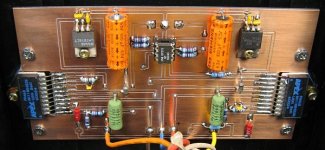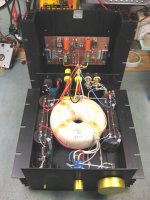There are a few threads here and there about these somewhat pricey power opamps.
The general thoughts are....they can be used like any of our chipamp circuits. But care needed regarding their S.O.A. , and good power supply noise rejection, and protection.
I am going to build an amp, or two, or three, or....
I have 11 of the PA12
http://apex.cirrus.com/en/pubs/proDatasheet/PA12U_R.pdf
All are "pulled" from motor speed-control products.
I guess Apex was bought/merged (?) with Cirrus Logic, so all the old Apex web links are almost gone. All the relevant info can now be found here:
http://apex.cirrus.com/en/products/apex/documents.html
Most applicable Application notes for audio amps are AN3, 8, 11, 17, 22
and this really great article:
Protect Those Expensive Power Op Amps
Digikey is now selling many of the Cirrus/Apex products, including the hard-to-find TO-3/8 sockets and heatsinks:
Digikey page
Has anyone "bridged" two of these before? There are a few diagrams in the Ap Notes...
Parallel Connections AN26

=RR=
The general thoughts are....they can be used like any of our chipamp circuits. But care needed regarding their S.O.A. , and good power supply noise rejection, and protection.
I am going to build an amp, or two, or three, or....
I have 11 of the PA12
http://apex.cirrus.com/en/pubs/proDatasheet/PA12U_R.pdf
All are "pulled" from motor speed-control products.
I guess Apex was bought/merged (?) with Cirrus Logic, so all the old Apex web links are almost gone. All the relevant info can now be found here:
http://apex.cirrus.com/en/products/apex/documents.html
Most applicable Application notes for audio amps are AN3, 8, 11, 17, 22
and this really great article:
Protect Those Expensive Power Op Amps
Digikey is now selling many of the Cirrus/Apex products, including the hard-to-find TO-3/8 sockets and heatsinks:
Digikey page
Has anyone "bridged" two of these before? There are a few diagrams in the Ap Notes...
Parallel Connections AN26

=RR=
I got a pair of PA46 from a friend.
I built a small 35W amp with them.
Sound pretty good. I would put some pictures here, but I don't know how.
I built a small 35W amp with them.
Sound pretty good. I would put some pictures here, but I don't know how.
Back in 1999 I built amps with the Apex PA19, PA05 and PA45 power op amps.
The PA19 is my favorite. It is nearly "blameless". The only deficiency I think I detect is a slight "MOSFET mist"; but this is very slight and possibly a subjective artifact. It is limited to 5 amps, so it probably shouldn't be used with low sensitive or difficult speakers.
The only deficiency I think I detect is a slight "MOSFET mist"; but this is very slight and possibly a subjective artifact. It is limited to 5 amps, so it probably shouldn't be used with low sensitive or difficult speakers.
The PA05 has better power but wasn't quite as transparent as the PA19. But I think the PA05 is comparable to a Krell 250, so it is very listenable. (By the way, one of my two chips died; so if someone wants to buy it, I will consider a offer, or if someone has a PA05 chip available I would consider buying a mate for mine.)
The PA45 is much more affordable and acceptable below 2 khz. But it lacked clarity at higher frequencies. I have forgotten the exact comparison, but the PA45 is in the same class as the LM3886 "gainclone". Maybe the PA45 was better on the low end and the LM3886 was a bit better on the high end. 😕
Next, I applied them as a triamp (with active crossovers) with the PA19 for the tweeter, PA05 on midrange and PA45 on the woofer. It worked out pretty good. Although the power capabilities of the PA05 was underutilized.
I have always been curious about the PA12. I will look forward to your reports on your project.
Recently, I listened to a LM4702 demo amp from National Semiconductor. In the brief time I could listen to it; I was very impressed. In the next few months, I plan to build an amp with the new National chips. Although I will probably try the LME49810 since it has a higher slew rate and more current output.
The PA19 is my favorite. It is nearly "blameless".
 The only deficiency I think I detect is a slight "MOSFET mist"; but this is very slight and possibly a subjective artifact. It is limited to 5 amps, so it probably shouldn't be used with low sensitive or difficult speakers.
The only deficiency I think I detect is a slight "MOSFET mist"; but this is very slight and possibly a subjective artifact. It is limited to 5 amps, so it probably shouldn't be used with low sensitive or difficult speakers.The PA05 has better power but wasn't quite as transparent as the PA19. But I think the PA05 is comparable to a Krell 250, so it is very listenable. (By the way, one of my two chips died; so if someone wants to buy it, I will consider a offer, or if someone has a PA05 chip available I would consider buying a mate for mine.)
The PA45 is much more affordable and acceptable below 2 khz. But it lacked clarity at higher frequencies. I have forgotten the exact comparison, but the PA45 is in the same class as the LM3886 "gainclone". Maybe the PA45 was better on the low end and the LM3886 was a bit better on the high end. 😕
Next, I applied them as a triamp (with active crossovers) with the PA19 for the tweeter, PA05 on midrange and PA45 on the woofer. It worked out pretty good. Although the power capabilities of the PA05 was underutilized.
I have always been curious about the PA12. I will look forward to your reports on your project.
Recently, I listened to a LM4702 demo amp from National Semiconductor. In the brief time I could listen to it; I was very impressed. In the next few months, I plan to build an amp with the new National chips. Although I will probably try the LME49810 since it has a higher slew rate and more current output.
Well, I have used Apex hybrids, though not for audio....
... still some comments.
These will probably do as good (or as bad, choose your camp) as any integrated/hybrid power opamp.
WRT bridging, while the Master/Slave concept is common in industrial apps and sometimes a life-saver, for audio bridging it doesn't seem to be the best topology (although one can find it implemented in many design there). The slave re-amplifies all the distortion/noise of the master.
- Klaus
... still some comments.
These will probably do as good (or as bad, choose your camp) as any integrated/hybrid power opamp.
WRT bridging, while the Master/Slave concept is common in industrial apps and sometimes a life-saver, for audio bridging it doesn't seem to be the best topology (although one can find it implemented in many design there). The slave re-amplifies all the distortion/noise of the master.
- Klaus
My friend ,who gave me the chips made one amp with the PA45's for O.Peterson. He liked it very much. I think this is an excellent sounding amp and it is easy to build.
Thanks. Almost everything is in this amp coming from surplus.
Except the input connectors and the knobs.
Except the input connectors and the knobs.
I thrive on surplus stuff.
I only order from Digikey once a year.
We have a large CNC at work, for wood and aluminum....6 foot by 12 foot. I wonder if it can do small pcb's ??
I have some 3oz copper board.
=FB=
I only order from Digikey once a year.
We have a large CNC at work, for wood and aluminum....6 foot by 12 foot. I wonder if it can do small pcb's ??
I have some 3oz copper board.
=FB=
Very nice,but tell a few words about the influence of the transformer (strayfield effect) to the chips.
Because of the poor distance from toroid to pcb maybe you have some "noise" on your speaker?
Because of the poor distance from toroid to pcb maybe you have some "noise" on your speaker?
- Status
- Not open for further replies.
- Home
- Amplifiers
- Chip Amps
- Apex power op amps









